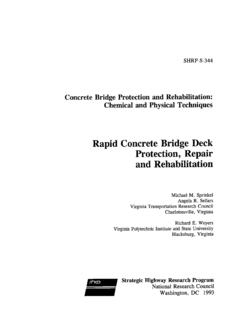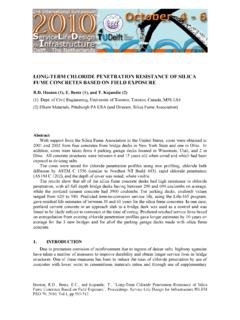Transcription of Construction of the Precast Segmental Approach Structures ...
1 , Page 1 Construction of the Precast Segmental Approach Structures for Sutong bridge Xian Peng LIU, CHEC Wuhan Port Construction Corp, China Zong Ping QIN, CHEC Wuhan Port Construction Corp, China LEUNG, YWL Engineering Pte Ltd, Singapore Dr. Lingling YUE, YWL Engineering Pte Ltd, Singapore Abstract The Precast Segmental Approach structure of the Sutong bridge with 75m span length was constructed using balanced cantilever method. This Precast Segmental viaduct was characterized by deep foundation in the riverbed, 60m high columns connecting the main bridge and relatively long end spans in the balanced cantilever deck.
2 This paper covers the Construction methods and logistics adopted to suit the particular site conditions. It discusses the casting yard selection and set up in the vicinity of the river bank, the design of the special equipment such as the short-line match casting moulds and two 160m long launching girders which were tailor-made for this project. The value engineering exercise in the post Contract award stage for facilitating Construction is detailed.
3 The geometry control method used in both the casting yard and erection front, the temporary works and stabilizing system are delineated. This paper also highlights the Construction difficulties encountered and solutions to the problems. Introduction The Sutong bridge is part of a traffic truck connecting cities Nantong and Suzhou (Changshu) across the Yangtze River in the south of Jiangsu Province (Figure 1). The total length of the highway is It consists of three parts: north bank link, central crossing and south bank link.
4 The central crossing consists of a total length of bridge Structures with 6-lane dual carriageway. The main navigation channel is a cable-stayed bridge that has a central span of 1088m. Both the north and south Approach Structures consist of 30m, 50m or 75m long span prestressed concrete continuous single-cell box girder structure to be constructed by either cast in-situ or Precast Segmental method. The Construction of the Precast Segmental Approach Structures commenced in April 2004 and completed in early 2007.
5 Figure 1: Location Plan , Page 2 The Sutong bridge project is located at the downstream of the Yangtze River close to the estuary with strong tidal effects at about 110 km from the river mouth. The site conditions were characterized by snow, storm, typhoon, strong tide, variable riverbed and rapid flow rate. The observed 30-year returned wind speed was The maximum difference between high tide and low tide observed was more than 5m. The maximum water depth was about 12m and the section flow rate was over 4m/s.
6 These environmental factors posed constraints and challenges to many Construction activities in this project. bridge Characteristics Being the first Precast Segmental bridge built using short-line match-casting method in China, the Approach structure consisted of 52 spans of single cell box girders. The typical bridge units were formed by 5-span or 10-span continuous deck supported on the pot bearings (Figure 2). The total length of the box girder measured along its centerline was approximate The deck width of a single carriageway was (Figure 3).
7 Other than one end span that was adjacent to the in-situ box girder at Natong side was a 50m unit, all other spans had an equal span length of 75m. The reinforced concrete columns with x rectangular hollow section were adopted for the maximum height of 60m and supported on pile caps with bored pile foundation. Figure 2: bridge Elevation Figure 3: bridge Sectional View , Page 3 Value Engineering The Engineer s original design of the Precast Segmental bridge deck was based on the balanced cantilever Construction technique using long-line casting method with epoxy joints.
8 A mixed prestressing system was employed. The cantilever and span tendons were internally prestressed while the continuity tendons were external. During the Tender stage, YWL Engineering was engaged by the Contractor (CHEC) to provide an alternative concept design for segment production using short-line match-casting method together with the associated value engineering exercise focusing on improving constructability. The detailed design was later executed by the original designer after award of the Contract.
9 Some key aspects of the value engineering included the following: i) Setting out concept of the box girder the box girder soffit was always horizontal in the Engineer s design; thus the cross section of the box was not symmetric about its centerline. The depth of two webs varied with respect to changes in super-elevation. The alternative setting out concept employed a constant depth section by allowing rotation in the box axis (Refer to Figure 4). This arrangement would simplify the mould design and casting operation in the production.
10 Figure 4: Box Girder Setting-Out Concept ii) Web transition details near the support, the web thickness was increased for shear resistance. The original design adopted a detail with continuous transition. The proposed alternative made use of a step discontinuity at segment joints so that the inner core form for the segment mould could be standardized and thus the casting operation would be simplified. See Figure 5. Figure 5: Box Girder Web Variation , Page 4 iii) Second stage casting of segment there was a significant difference in self-weight between the typical and diaphragm segments (285 150 = 136 ton).







